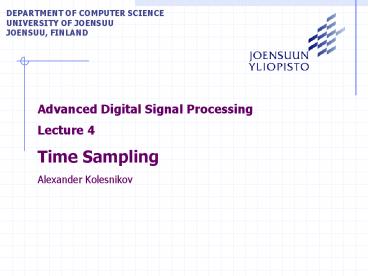Advanced Digital Signal Processing - PowerPoint PPT Presentation
1 / 24
Title:
Advanced Digital Signal Processing
Description:
Dirac comb-function. t. T. Fourier transform of the function: Fourier transform of sampled signal ... Fourier transform of Dirac comb-function h(t): F{x(t)}=Fx ... – PowerPoint PPT presentation
Number of Views:101
Avg rating:3.0/5.0
Title: Advanced Digital Signal Processing
1
DEPARTMENT OF COMPUTER SCIENCE UNIVERSITY OF
JOENSUU JOENSUU, FINLAND
- Advanced Digital Signal Processing
- Lecture 4
- Time Sampling
- Alexander Kolesnikov
2
Digitizing data
- Digitizing the data is the process of converting
a - continous waveform (signal) into discrete
numbers. - The process is completed using an
analog-to-digital - converter.
- 1) Time Sampling (time quantization)
- 2) Quantization (value quantization)
3
ime Sampling
- The conversion process between continuous time
signal and discrete time signal is sampling.
T
Continuous time signal
Discrete time signal
4
Sampled signal
Let us sample the continuous-time non-periodic
signal x(t) at equal intervals T, to generate
the sequence , x(?kT),, x(?T), x(0),
x(T),..., x(kT), ...
y(t)
x(t)
5
Dirac comb-function
t
T
Fourier transform of the function
6
Fourier transform of sampled signal
- Fourier transform of the signal x(t)
Fx(t)Fx(?) - Fourier transform of Dirac comb-function h(t)
Fx(t)Fx(?) - Fourier transform of the signal y(t)x(t)h(t)
- is convolution of Fourier transforms of x(t)
and h(t)
http//www.dsptutor.freeuk.com/aliasing/AliasingDe
mo.html
http//www.jhu.edu/signals/sampling/index.html
7
Fourier transform of sampled signal y(t)
8
Power spectrum of sampled signal y(t)
- Power spectrum of the input continuous signal
x(t)
- Power spectrum of the sampled signal
y(t)x(t)h(t)
Sx(?) Sy(?)
9
Example T1
-?/T
?/T
Sx(?)
?maxlt?/T
Sx(?)
Sy(?)
10
Example T2 gtT1
Sx(?) Sy(?)
?maxgt?/T
11
Example T3 gtT2 gtT1
Sx(?) Sy(?)
?max gt?/T
12
Aliasing
As sampling interval T increases, 2?/T decreases
and starting from some moment two neighbouring
copies will interact ? amplitude spectrum
Fy(?) of sampled signal y(t) does not represent
in ??/Tlt?lt?/T the amplitude spectrum of signal
x(t).
Sx(?) Sy(?)
13
Critical frequency
The critical frequency ?s is defined as twice
the bandwidth.
?max ?? /T ? ?s2?/T ? 2?max
This is Nyquist frequency ?N 2 ?max If the
samlping frequency is exactly twice the
highest frequency of the input signal, then
phase mismatches between the sampler and the
signal will distort the signal. For example,
samling cos(?T) at T0,1,2, will give the
discrete signal cos(?n), as desired. However,
sampling the same signal at t0.5, 1.5, ...
will give a constant zero.
14
Band-limited signal
Let x(t) is a band-limited function
Sx(?)0 for ?gt ?max. Then the maximum time
interval allowed between the samples is
Tmax?/?max
?? max
15
What to do?
If the samling condition is not satisfied, the
frequencies will overlap (aliasing). To pervent
aliasing, two things can be done 1) Increase
the sampling rate (decrease T) ?s2?max 2)
Introduce anti-aliasing filter restrict the
bandwith of the signal to satisfy the sampling
condition.
In practice, signal has some energy outside the
bandwidth. However, the energy can be small
enough that the aliasing effects are neglegible
16
Signal reconstruction
Reconstruct continuous signal x(t) from the
discrete sampled signal y(t).
1) 0-order interpolator 2) 1-order
interpolator 3) polynomial, splines, etc.
Can we reconstruct input signal x(t) without
error?
17
Zero-order interpolation
Red - sampled signal Blue - reconstructed signal
18
First-order interpolation
Red - sampled signal Blue - reconstructed signal
19
Interpolation with sinc-function
Red - sampled signal Blue - reconstructed signal
20
Sampling theorem
A band-limited signal x(t) with bandwidth ?max is
completely determined by the countable set of
samples x(kT) of the signal x(t), if the
sampling interval satisfies T??/?max Furthermore,
it may be obtained from these values by the
following equality
Whittaker-Nyquist-Kotelnikov-Shannon Sampling
Theorem
21
Sinc-function
Reconctructed signal is convolution of sampled
signal y(t) with function sinc(t)
where
Fourier spectrum of sinc(t)
22
Signal restoration time axis
Restored signal is convolution of sampled
signal with interpolating function g(t)sinc(t)
Fourier transform of function g(t)sinc(t)
23
Signal restoration frequency axis
On time axis
On frequency axis
For band-limited signal
24
Problems
- Aliasing in passband signals.
- Optimal pre- and post-filtering of signals
- Anti-aliasing filter before down-sampling.































